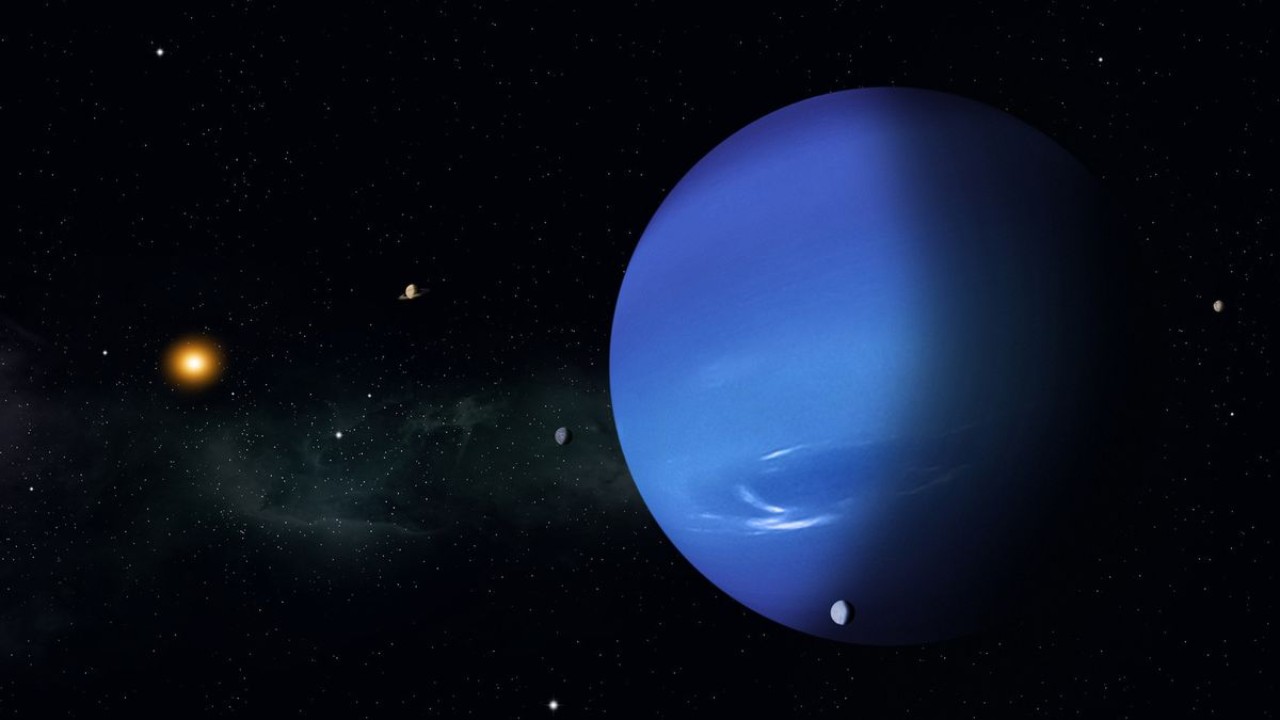Neptune’s newest and tiniest moon is probably an ancient piece of a much larger moon orbiting unusually close. California astronomers
shone a light on
the 34-kilometer-diameter moon ‘Hippocamp’ in a new study
published in
Nature this week. The moon is named after the mythological sea horse ‘Hippokampos’. Mark Showalter, a researcher at the SETI Institute in California, discovered the icy
Neptune’s fourteenth moon in 2013
using images captured by the
Hubble Space Telescope
. Showalter and his research team have suggested that Hippocamp was formed billions of years ago when a comet rammed into Proteus
— the largest of Neptune’s seven inner moons. [caption id=“attachment_6129931” align=“alignnone” width=“1280”] An early image of Hippocamp taken in 2004 by Hubble Space Telescope. Image courtesy: Mark Showalter/SETI Institute[/caption] Proteus and Hippocamp orbit Neptune just 12,000 kilometers away from each other. That’s suspiciously close in the context of astronomy, except that researchers think they were probably even closer in the past before Proteus began migrated outwards. Scientists have long believed Neptune’s inner moons were repeatedly broken apart by collisions with comets, Showalter
told
the Associated Press. “The discovery of Hippocamp, orbiting so close to the much larger moon Proteus, provides a particularly dramatic illustration of the Neptune system’s battered history,” Showalter said in an email. Researchers haven’t ruled out the possibility that Hippocamp and Proteus are unrelated, and the “tiny size and peculiar location” of Hippocamp support the theory that Proteus formed independently. [caption id=“attachment_6129941” align=“alignnone” width=“1280”]
An early image of Hippocamp taken in 2004 by Hubble Space Telescope. Image courtesy: Mark Showalter/SETI Institute[/caption] Proteus and Hippocamp orbit Neptune just 12,000 kilometers away from each other. That’s suspiciously close in the context of astronomy, except that researchers think they were probably even closer in the past before Proteus began migrated outwards. Scientists have long believed Neptune’s inner moons were repeatedly broken apart by collisions with comets, Showalter
told
the Associated Press. “The discovery of Hippocamp, orbiting so close to the much larger moon Proteus, provides a particularly dramatic illustration of the Neptune system’s battered history,” Showalter said in an email. Researchers haven’t ruled out the possibility that Hippocamp and Proteus are unrelated, and the “tiny size and peculiar location” of Hippocamp support the theory that Proteus formed independently. [caption id=“attachment_6129941” align=“alignnone” width=“1280”] Relative sizes of a few of Neptune’s moons, including Hippocamp. Image credit: Mark Showalter/SETI Institute[/caption]
NASA’s Voyager 2
spacecraft discovered Proteus way back in 1989, after which it’s been known as Neptune’s second-largest, dark and irregularly-shaped moon. Voyager 2 also beamed back pictures of a huge impact crater on Proteus. Thanks to the Hubble telescope, we now know that “a little piece of Proteus got left behind and we see it today as Hippocamp,” Showalter said in
a statement
. Under normal circumstance, when two moons are as close together as Proteus and Hippocamp are, the larger one either knocks the small one right out of its orbit or merges with it in a collision. But as far as Hippocamp is concerned, neither of the two has displaced the tiny moon just yet. Showalter said he looked for more signs of little moons around Neptune in Hubble’s data, adding that he wouldn’t be surprised if he found more. But the only way to find them for real is to have a spacecraft fly around the planet.
Relative sizes of a few of Neptune’s moons, including Hippocamp. Image credit: Mark Showalter/SETI Institute[/caption]
NASA’s Voyager 2
spacecraft discovered Proteus way back in 1989, after which it’s been known as Neptune’s second-largest, dark and irregularly-shaped moon. Voyager 2 also beamed back pictures of a huge impact crater on Proteus. Thanks to the Hubble telescope, we now know that “a little piece of Proteus got left behind and we see it today as Hippocamp,” Showalter said in
a statement
. Under normal circumstance, when two moons are as close together as Proteus and Hippocamp are, the larger one either knocks the small one right out of its orbit or merges with it in a collision. But as far as Hippocamp is concerned, neither of the two has displaced the tiny moon just yet. Showalter said he looked for more signs of little moons around Neptune in Hubble’s data, adding that he wouldn’t be surprised if he found more. But the only way to find them for real is to have a spacecraft fly around the planet.
Is Neptune's tiny, new moon just debris from an ancient collision with comets?
tech2 News Staff
• February 21, 2019, 18:19:32 IST
The new moon & Neptune’s second largest, Proteus, are suspiciously close in the context of astronomy.
Advertisement
)
End of Article